BSc Business Management: Information Systems & Big Data Analysis
VerifiedAdded on 2023/06/10
|8
|1841
|433
Report
AI Summary
This report provides an overview of big data, its characteristics (volume, variety, veracity, value, velocity), and the challenges associated with its analysis, including the lack of skilled professionals and data growth issues. It explores various techniques for analyzing big data, such as A/B testing, data fusion, data integration, data mining, machine learning, and statistics, highlighting their applications in improving business operations and decision-making. The report further discusses how big data technology can support businesses by aiding in decision-making, improving existing products through customer feedback, ensuring data safety, and aligning activities with customer preferences. It concludes that big data analytics is crucial for business success, enabling better decision-making and data-driven strategies.
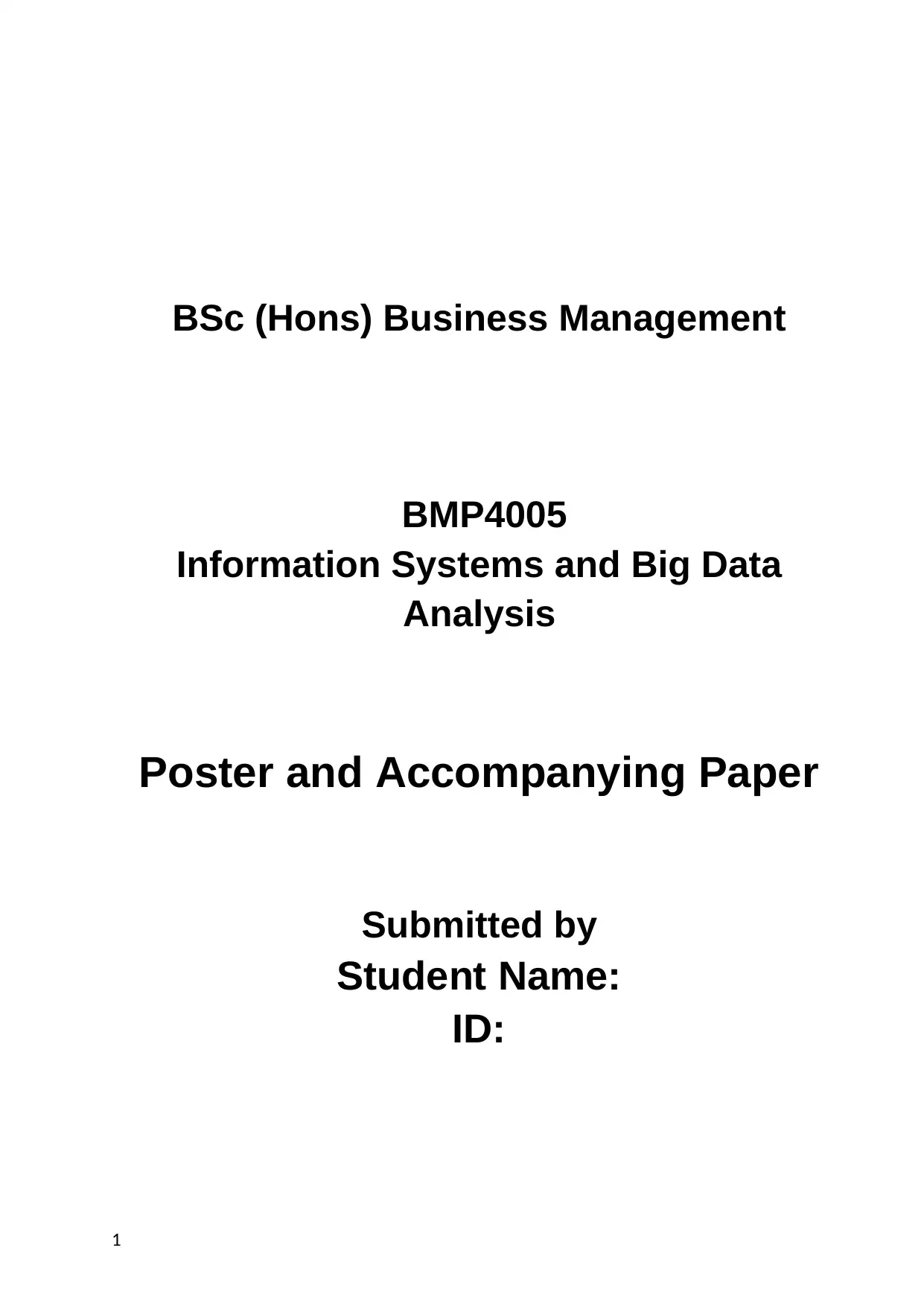
BSc (Hons) Business Management
BMP4005
Information Systems and Big Data
Analysis
Poster and Accompanying Paper
Submitted by
Student Name:
ID:
1
BMP4005
Information Systems and Big Data
Analysis
Poster and Accompanying Paper
Submitted by
Student Name:
ID:
1
Paraphrase This Document
Need a fresh take? Get an instant paraphrase of this document with our AI Paraphraser
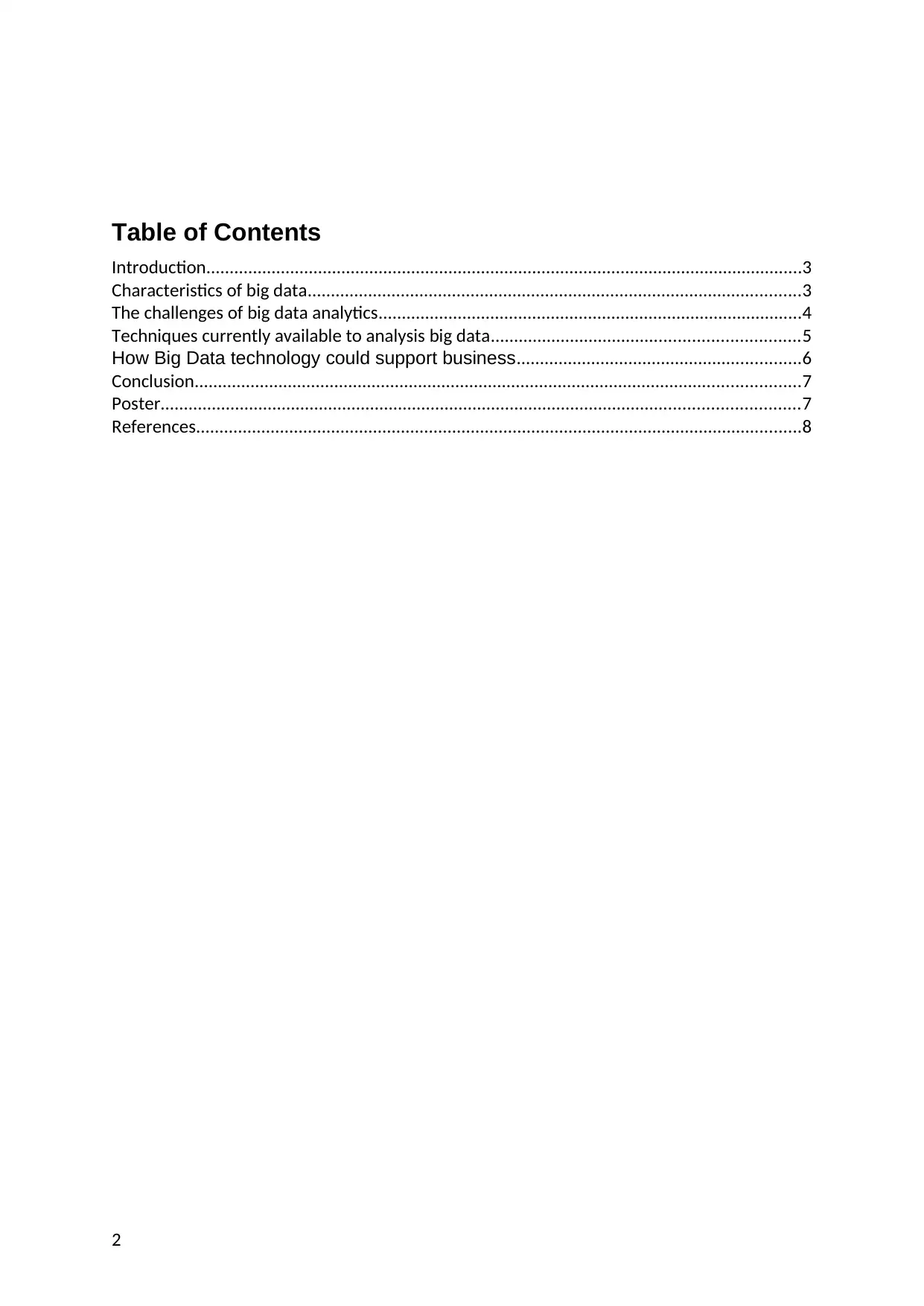
Table of Contents
Introduction................................................................................................................................3
Characteristics of big data..........................................................................................................3
The challenges of big data analytics...........................................................................................4
Techniques currently available to analysis big data..................................................................5
How Big Data technology could support business.............................................................6
Conclusion..................................................................................................................................7
Poster.........................................................................................................................................7
References..................................................................................................................................8
2
Introduction................................................................................................................................3
Characteristics of big data..........................................................................................................3
The challenges of big data analytics...........................................................................................4
Techniques currently available to analysis big data..................................................................5
How Big Data technology could support business.............................................................6
Conclusion..................................................................................................................................7
Poster.........................................................................................................................................7
References..................................................................................................................................8
2
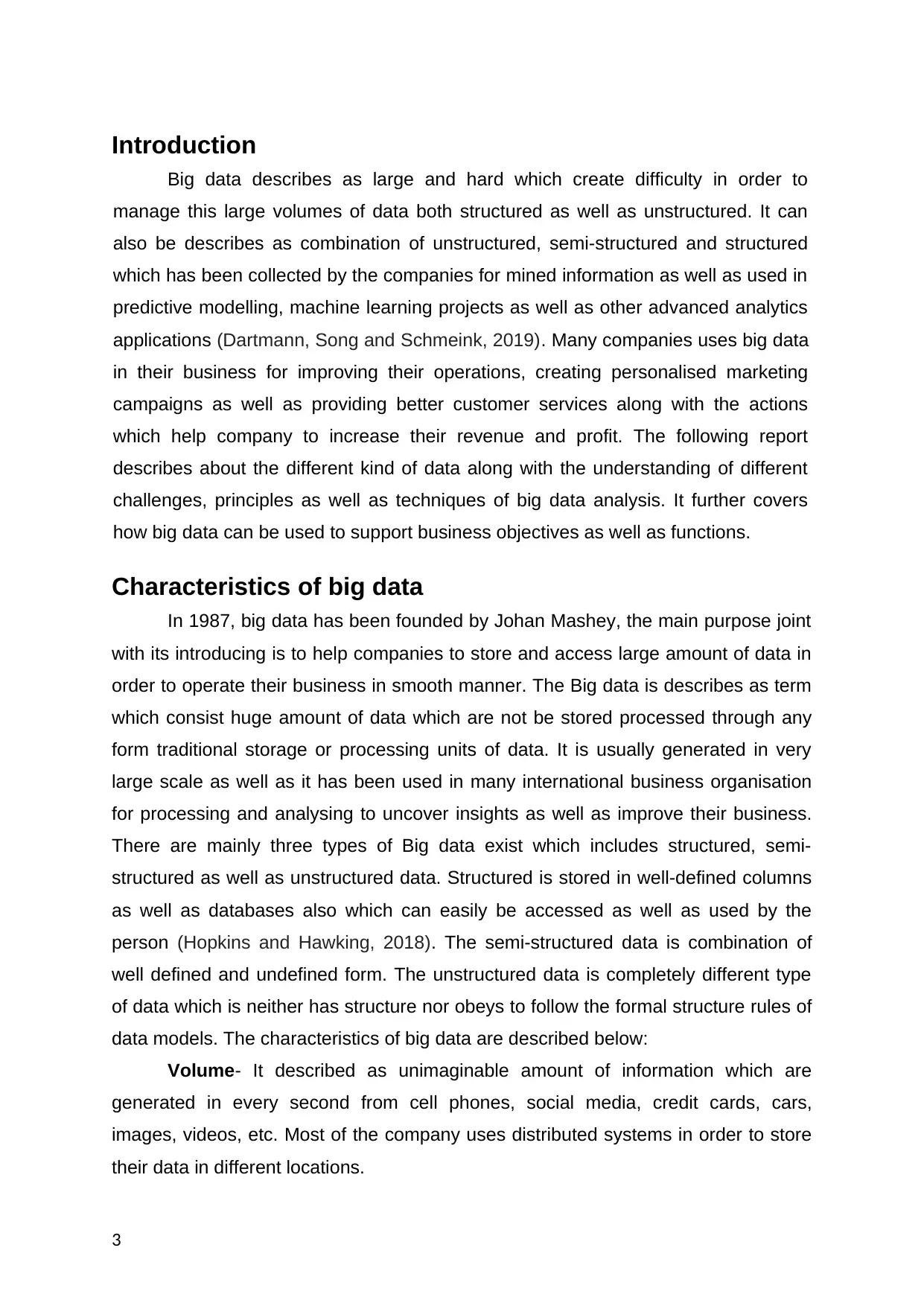
Introduction
Big data describes as large and hard which create difficulty in order to
manage this large volumes of data both structured as well as unstructured. It can
also be describes as combination of unstructured, semi-structured and structured
which has been collected by the companies for mined information as well as used in
predictive modelling, machine learning projects as well as other advanced analytics
applications (Dartmann, Song and Schmeink, 2019). Many companies uses big data
in their business for improving their operations, creating personalised marketing
campaigns as well as providing better customer services along with the actions
which help company to increase their revenue and profit. The following report
describes about the different kind of data along with the understanding of different
challenges, principles as well as techniques of big data analysis. It further covers
how big data can be used to support business objectives as well as functions.
Characteristics of big data
In 1987, big data has been founded by Johan Mashey, the main purpose joint
with its introducing is to help companies to store and access large amount of data in
order to operate their business in smooth manner. The Big data is describes as term
which consist huge amount of data which are not be stored processed through any
form traditional storage or processing units of data. It is usually generated in very
large scale as well as it has been used in many international business organisation
for processing and analysing to uncover insights as well as improve their business.
There are mainly three types of Big data exist which includes structured, semi-
structured as well as unstructured data. Structured is stored in well-defined columns
as well as databases also which can easily be accessed as well as used by the
person (Hopkins and Hawking, 2018). The semi-structured data is combination of
well defined and undefined form. The unstructured data is completely different type
of data which is neither has structure nor obeys to follow the formal structure rules of
data models. The characteristics of big data are described below:
Volume- It described as unimaginable amount of information which are
generated in every second from cell phones, social media, credit cards, cars,
images, videos, etc. Most of the company uses distributed systems in order to store
their data in different locations.
3
Big data describes as large and hard which create difficulty in order to
manage this large volumes of data both structured as well as unstructured. It can
also be describes as combination of unstructured, semi-structured and structured
which has been collected by the companies for mined information as well as used in
predictive modelling, machine learning projects as well as other advanced analytics
applications (Dartmann, Song and Schmeink, 2019). Many companies uses big data
in their business for improving their operations, creating personalised marketing
campaigns as well as providing better customer services along with the actions
which help company to increase their revenue and profit. The following report
describes about the different kind of data along with the understanding of different
challenges, principles as well as techniques of big data analysis. It further covers
how big data can be used to support business objectives as well as functions.
Characteristics of big data
In 1987, big data has been founded by Johan Mashey, the main purpose joint
with its introducing is to help companies to store and access large amount of data in
order to operate their business in smooth manner. The Big data is describes as term
which consist huge amount of data which are not be stored processed through any
form traditional storage or processing units of data. It is usually generated in very
large scale as well as it has been used in many international business organisation
for processing and analysing to uncover insights as well as improve their business.
There are mainly three types of Big data exist which includes structured, semi-
structured as well as unstructured data. Structured is stored in well-defined columns
as well as databases also which can easily be accessed as well as used by the
person (Hopkins and Hawking, 2018). The semi-structured data is combination of
well defined and undefined form. The unstructured data is completely different type
of data which is neither has structure nor obeys to follow the formal structure rules of
data models. The characteristics of big data are described below:
Volume- It described as unimaginable amount of information which are
generated in every second from cell phones, social media, credit cards, cars,
images, videos, etc. Most of the company uses distributed systems in order to store
their data in different locations.
3
⊘ This is a preview!⊘
Do you want full access?
Subscribe today to unlock all pages.

Trusted by 1+ million students worldwide
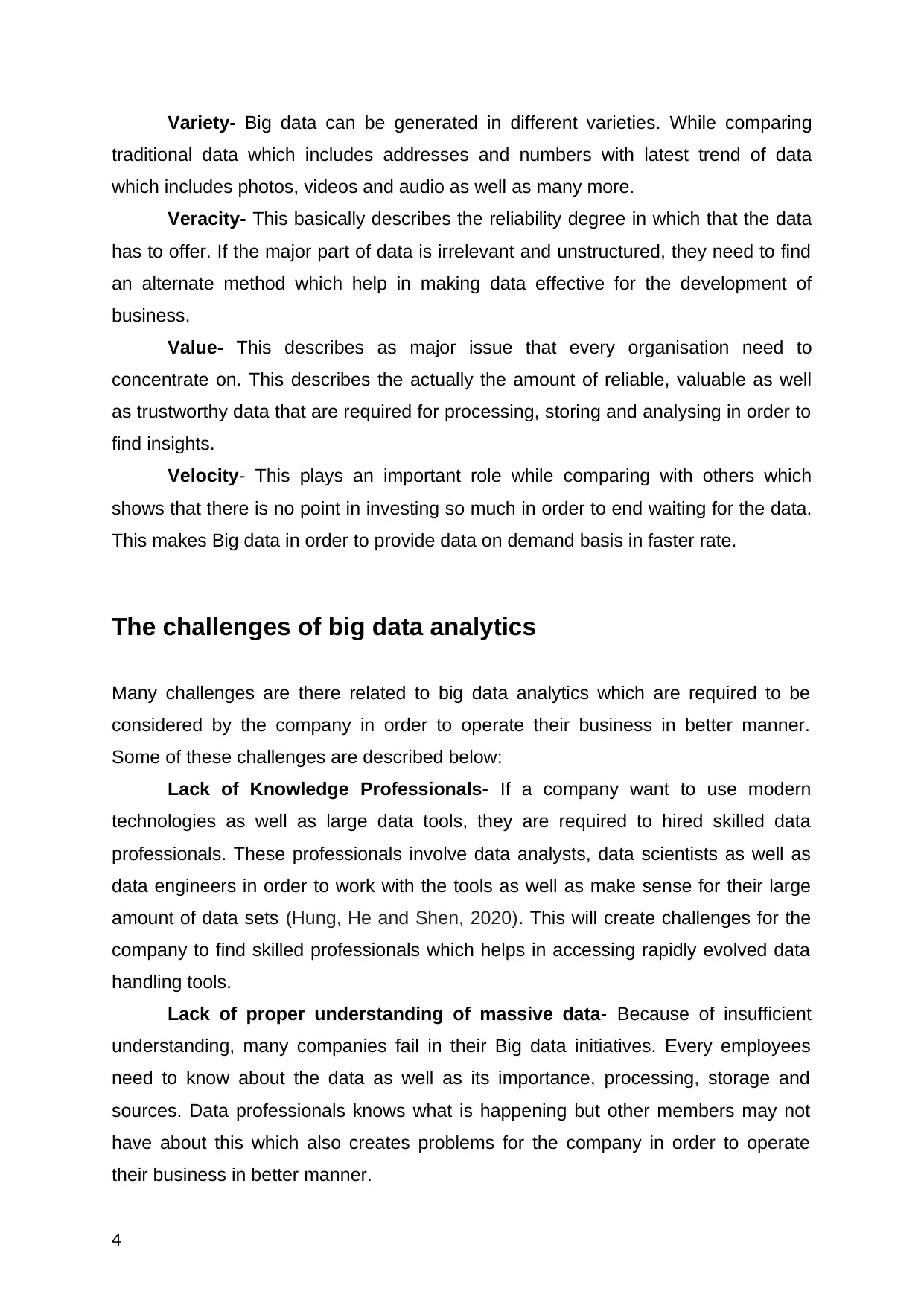
Variety- Big data can be generated in different varieties. While comparing
traditional data which includes addresses and numbers with latest trend of data
which includes photos, videos and audio as well as many more.
Veracity- This basically describes the reliability degree in which that the data
has to offer. If the major part of data is irrelevant and unstructured, they need to find
an alternate method which help in making data effective for the development of
business.
Value- This describes as major issue that every organisation need to
concentrate on. This describes the actually the amount of reliable, valuable as well
as trustworthy data that are required for processing, storing and analysing in order to
find insights.
Velocity- This plays an important role while comparing with others which
shows that there is no point in investing so much in order to end waiting for the data.
This makes Big data in order to provide data on demand basis in faster rate.
The challenges of big data analytics
Many challenges are there related to big data analytics which are required to be
considered by the company in order to operate their business in better manner.
Some of these challenges are described below:
Lack of Knowledge Professionals- If a company want to use modern
technologies as well as large data tools, they are required to hired skilled data
professionals. These professionals involve data analysts, data scientists as well as
data engineers in order to work with the tools as well as make sense for their large
amount of data sets (Hung, He and Shen, 2020). This will create challenges for the
company to find skilled professionals which helps in accessing rapidly evolved data
handling tools.
Lack of proper understanding of massive data- Because of insufficient
understanding, many companies fail in their Big data initiatives. Every employees
need to know about the data as well as its importance, processing, storage and
sources. Data professionals knows what is happening but other members may not
have about this which also creates problems for the company in order to operate
their business in better manner.
4
traditional data which includes addresses and numbers with latest trend of data
which includes photos, videos and audio as well as many more.
Veracity- This basically describes the reliability degree in which that the data
has to offer. If the major part of data is irrelevant and unstructured, they need to find
an alternate method which help in making data effective for the development of
business.
Value- This describes as major issue that every organisation need to
concentrate on. This describes the actually the amount of reliable, valuable as well
as trustworthy data that are required for processing, storing and analysing in order to
find insights.
Velocity- This plays an important role while comparing with others which
shows that there is no point in investing so much in order to end waiting for the data.
This makes Big data in order to provide data on demand basis in faster rate.
The challenges of big data analytics
Many challenges are there related to big data analytics which are required to be
considered by the company in order to operate their business in better manner.
Some of these challenges are described below:
Lack of Knowledge Professionals- If a company want to use modern
technologies as well as large data tools, they are required to hired skilled data
professionals. These professionals involve data analysts, data scientists as well as
data engineers in order to work with the tools as well as make sense for their large
amount of data sets (Hung, He and Shen, 2020). This will create challenges for the
company to find skilled professionals which helps in accessing rapidly evolved data
handling tools.
Lack of proper understanding of massive data- Because of insufficient
understanding, many companies fail in their Big data initiatives. Every employees
need to know about the data as well as its importance, processing, storage and
sources. Data professionals knows what is happening but other members may not
have about this which also creates problems for the company in order to operate
their business in better manner.
4
Paraphrase This Document
Need a fresh take? Get an instant paraphrase of this document with our AI Paraphraser
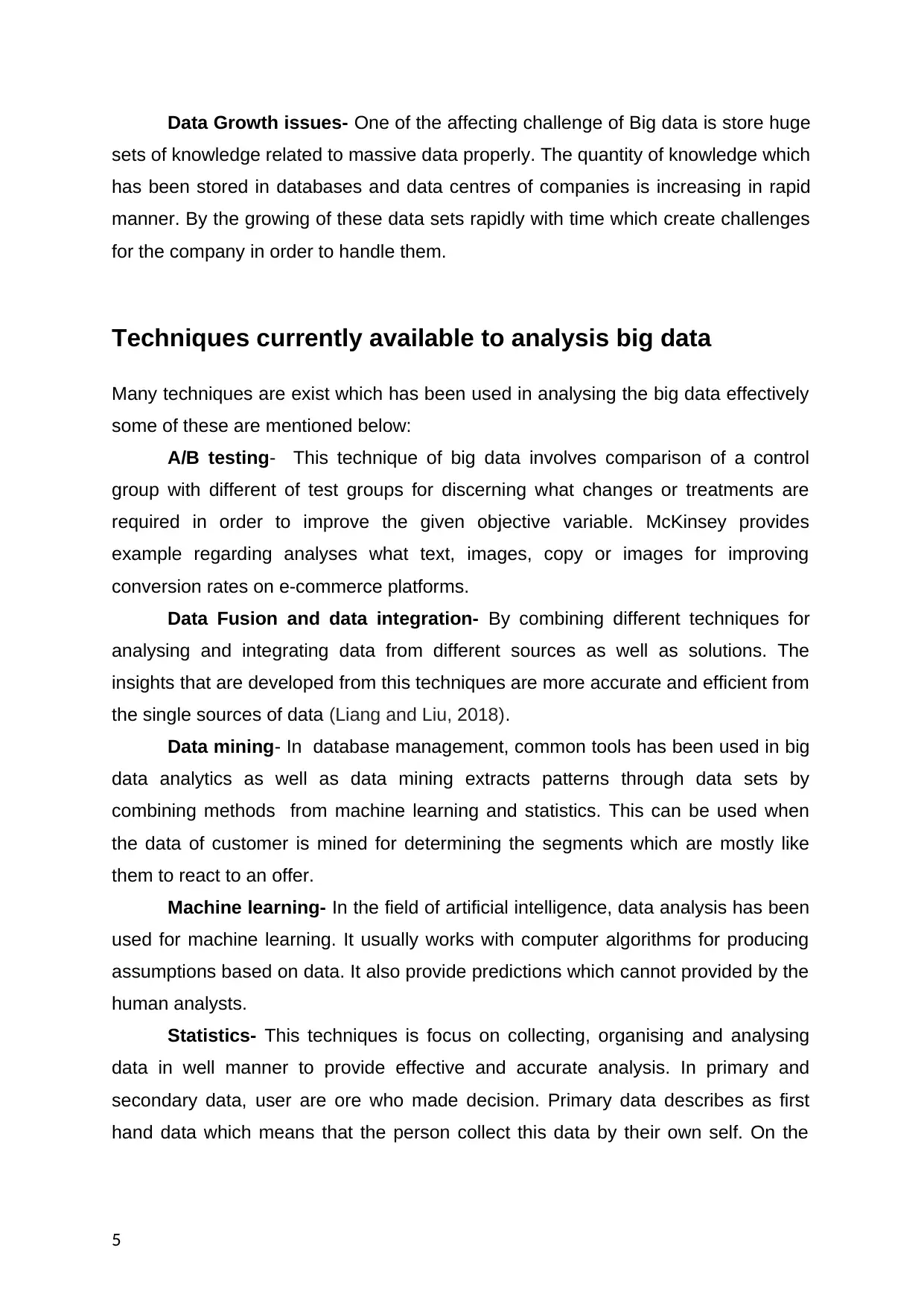
Data Growth issues- One of the affecting challenge of Big data is store huge
sets of knowledge related to massive data properly. The quantity of knowledge which
has been stored in databases and data centres of companies is increasing in rapid
manner. By the growing of these data sets rapidly with time which create challenges
for the company in order to handle them.
Techniques currently available to analysis big data
Many techniques are exist which has been used in analysing the big data effectively
some of these are mentioned below:
A/B testing- This technique of big data involves comparison of a control
group with different of test groups for discerning what changes or treatments are
required in order to improve the given objective variable. McKinsey provides
example regarding analyses what text, images, copy or images for improving
conversion rates on e-commerce platforms.
Data Fusion and data integration- By combining different techniques for
analysing and integrating data from different sources as well as solutions. The
insights that are developed from this techniques are more accurate and efficient from
the single sources of data (Liang and Liu, 2018).
Data mining- In database management, common tools has been used in big
data analytics as well as data mining extracts patterns through data sets by
combining methods from machine learning and statistics. This can be used when
the data of customer is mined for determining the segments which are mostly like
them to react to an offer.
Machine learning- In the field of artificial intelligence, data analysis has been
used for machine learning. It usually works with computer algorithms for producing
assumptions based on data. It also provide predictions which cannot provided by the
human analysts.
Statistics- This techniques is focus on collecting, organising and analysing
data in well manner to provide effective and accurate analysis. In primary and
secondary data, user are ore who made decision. Primary data describes as first
hand data which means that the person collect this data by their own self. On the
5
sets of knowledge related to massive data properly. The quantity of knowledge which
has been stored in databases and data centres of companies is increasing in rapid
manner. By the growing of these data sets rapidly with time which create challenges
for the company in order to handle them.
Techniques currently available to analysis big data
Many techniques are exist which has been used in analysing the big data effectively
some of these are mentioned below:
A/B testing- This technique of big data involves comparison of a control
group with different of test groups for discerning what changes or treatments are
required in order to improve the given objective variable. McKinsey provides
example regarding analyses what text, images, copy or images for improving
conversion rates on e-commerce platforms.
Data Fusion and data integration- By combining different techniques for
analysing and integrating data from different sources as well as solutions. The
insights that are developed from this techniques are more accurate and efficient from
the single sources of data (Liang and Liu, 2018).
Data mining- In database management, common tools has been used in big
data analytics as well as data mining extracts patterns through data sets by
combining methods from machine learning and statistics. This can be used when
the data of customer is mined for determining the segments which are mostly like
them to react to an offer.
Machine learning- In the field of artificial intelligence, data analysis has been
used for machine learning. It usually works with computer algorithms for producing
assumptions based on data. It also provide predictions which cannot provided by the
human analysts.
Statistics- This techniques is focus on collecting, organising and analysing
data in well manner to provide effective and accurate analysis. In primary and
secondary data, user are ore who made decision. Primary data describes as first
hand data which means that the person collect this data by their own self. On the
5
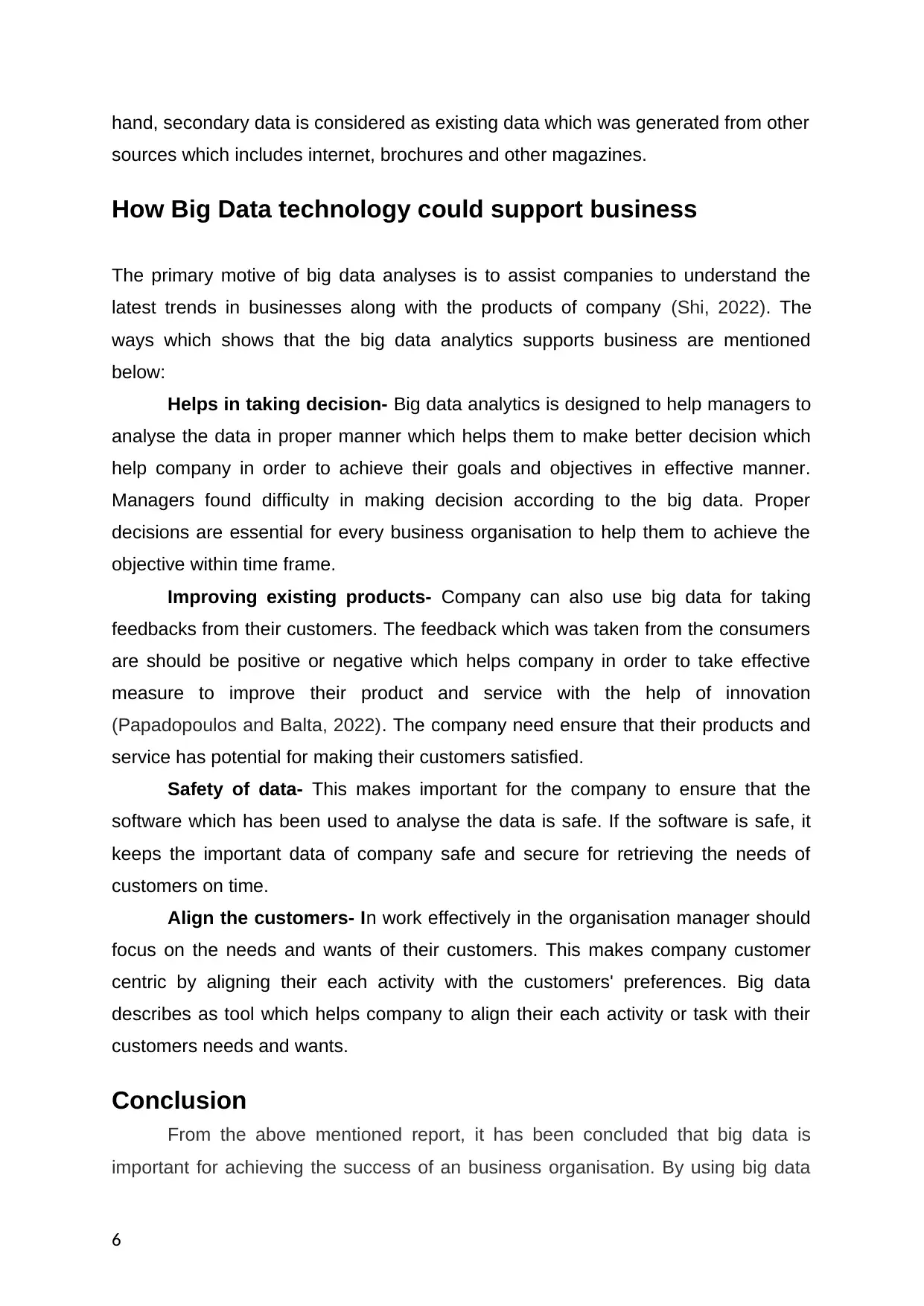
hand, secondary data is considered as existing data which was generated from other
sources which includes internet, brochures and other magazines.
How Big Data technology could support business
The primary motive of big data analyses is to assist companies to understand the
latest trends in businesses along with the products of company (Shi, 2022). The
ways which shows that the big data analytics supports business are mentioned
below:
Helps in taking decision- Big data analytics is designed to help managers to
analyse the data in proper manner which helps them to make better decision which
help company in order to achieve their goals and objectives in effective manner.
Managers found difficulty in making decision according to the big data. Proper
decisions are essential for every business organisation to help them to achieve the
objective within time frame.
Improving existing products- Company can also use big data for taking
feedbacks from their customers. The feedback which was taken from the consumers
are should be positive or negative which helps company in order to take effective
measure to improve their product and service with the help of innovation
(Papadopoulos and Balta, 2022). The company need ensure that their products and
service has potential for making their customers satisfied.
Safety of data- This makes important for the company to ensure that the
software which has been used to analyse the data is safe. If the software is safe, it
keeps the important data of company safe and secure for retrieving the needs of
customers on time.
Align the customers- In work effectively in the organisation manager should
focus on the needs and wants of their customers. This makes company customer
centric by aligning their each activity with the customers' preferences. Big data
describes as tool which helps company to align their each activity or task with their
customers needs and wants.
Conclusion
From the above mentioned report, it has been concluded that big data is
important for achieving the success of an business organisation. By using big data
6
sources which includes internet, brochures and other magazines.
How Big Data technology could support business
The primary motive of big data analyses is to assist companies to understand the
latest trends in businesses along with the products of company (Shi, 2022). The
ways which shows that the big data analytics supports business are mentioned
below:
Helps in taking decision- Big data analytics is designed to help managers to
analyse the data in proper manner which helps them to make better decision which
help company in order to achieve their goals and objectives in effective manner.
Managers found difficulty in making decision according to the big data. Proper
decisions are essential for every business organisation to help them to achieve the
objective within time frame.
Improving existing products- Company can also use big data for taking
feedbacks from their customers. The feedback which was taken from the consumers
are should be positive or negative which helps company in order to take effective
measure to improve their product and service with the help of innovation
(Papadopoulos and Balta, 2022). The company need ensure that their products and
service has potential for making their customers satisfied.
Safety of data- This makes important for the company to ensure that the
software which has been used to analyse the data is safe. If the software is safe, it
keeps the important data of company safe and secure for retrieving the needs of
customers on time.
Align the customers- In work effectively in the organisation manager should
focus on the needs and wants of their customers. This makes company customer
centric by aligning their each activity with the customers' preferences. Big data
describes as tool which helps company to align their each activity or task with their
customers needs and wants.
Conclusion
From the above mentioned report, it has been concluded that big data is
important for achieving the success of an business organisation. By using big data
6
⊘ This is a preview!⊘
Do you want full access?
Subscribe today to unlock all pages.

Trusted by 1+ million students worldwide
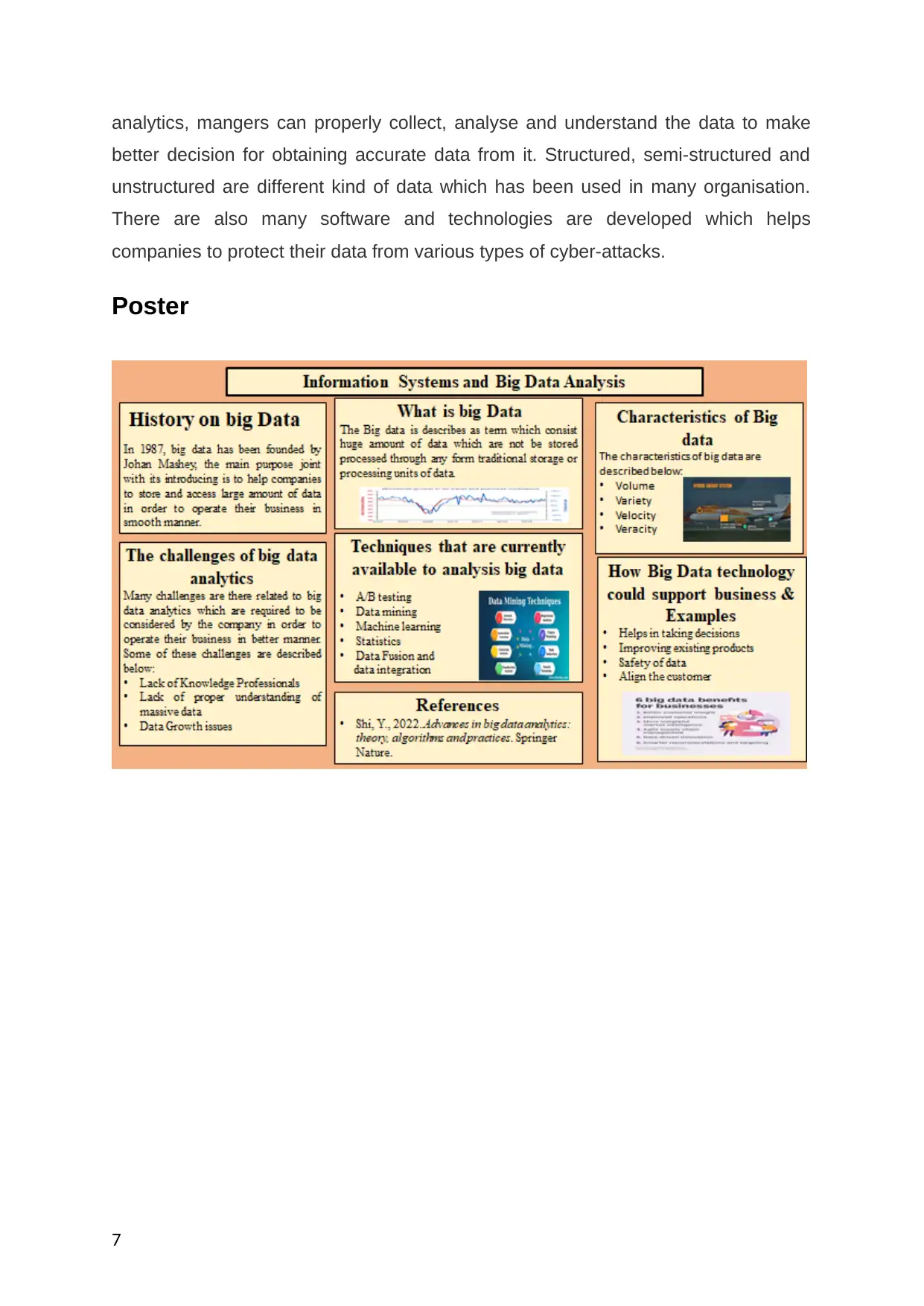
analytics, mangers can properly collect, analyse and understand the data to make
better decision for obtaining accurate data from it. Structured, semi-structured and
unstructured are different kind of data which has been used in many organisation.
There are also many software and technologies are developed which helps
companies to protect their data from various types of cyber-attacks.
Poster
7
better decision for obtaining accurate data from it. Structured, semi-structured and
unstructured are different kind of data which has been used in many organisation.
There are also many software and technologies are developed which helps
companies to protect their data from various types of cyber-attacks.
Poster
7
Paraphrase This Document
Need a fresh take? Get an instant paraphrase of this document with our AI Paraphraser
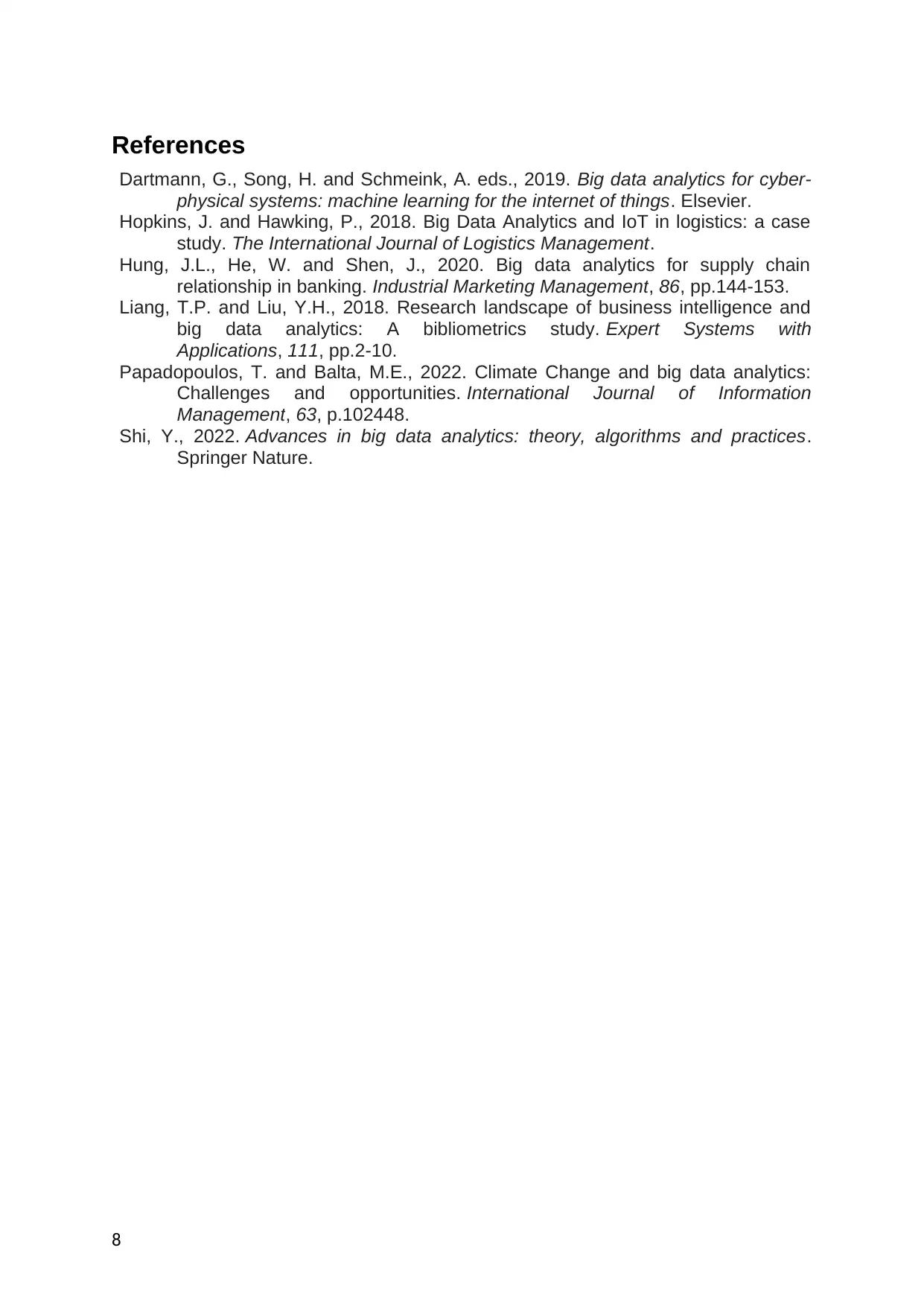
References
Dartmann, G., Song, H. and Schmeink, A. eds., 2019. Big data analytics for cyber-
physical systems: machine learning for the internet of things. Elsevier.
Hopkins, J. and Hawking, P., 2018. Big Data Analytics and IoT in logistics: a case
study. The International Journal of Logistics Management.
Hung, J.L., He, W. and Shen, J., 2020. Big data analytics for supply chain
relationship in banking. Industrial Marketing Management, 86, pp.144-153.
Liang, T.P. and Liu, Y.H., 2018. Research landscape of business intelligence and
big data analytics: A bibliometrics study. Expert Systems with
Applications, 111, pp.2-10.
Papadopoulos, T. and Balta, M.E., 2022. Climate Change and big data analytics:
Challenges and opportunities. International Journal of Information
Management, 63, p.102448.
Shi, Y., 2022. Advances in big data analytics: theory, algorithms and practices.
Springer Nature.
8
Dartmann, G., Song, H. and Schmeink, A. eds., 2019. Big data analytics for cyber-
physical systems: machine learning for the internet of things. Elsevier.
Hopkins, J. and Hawking, P., 2018. Big Data Analytics and IoT in logistics: a case
study. The International Journal of Logistics Management.
Hung, J.L., He, W. and Shen, J., 2020. Big data analytics for supply chain
relationship in banking. Industrial Marketing Management, 86, pp.144-153.
Liang, T.P. and Liu, Y.H., 2018. Research landscape of business intelligence and
big data analytics: A bibliometrics study. Expert Systems with
Applications, 111, pp.2-10.
Papadopoulos, T. and Balta, M.E., 2022. Climate Change and big data analytics:
Challenges and opportunities. International Journal of Information
Management, 63, p.102448.
Shi, Y., 2022. Advances in big data analytics: theory, algorithms and practices.
Springer Nature.
8
1 out of 8
Related Documents
Your All-in-One AI-Powered Toolkit for Academic Success.
+13062052269
info@desklib.com
Available 24*7 on WhatsApp / Email
![[object Object]](/_next/static/media/star-bottom.7253800d.svg)
Unlock your academic potential
Copyright © 2020–2025 A2Z Services. All Rights Reserved. Developed and managed by ZUCOL.

